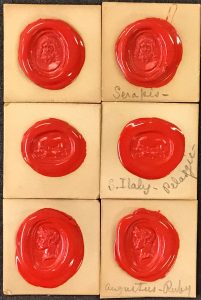In 1895, at the memorial service for Augustus Chapman Merriam, Professor of Archaeology and Epigraphy, one of the speakers was Ogden Nicholas Rood, Professor of Physics. He started his remarks by stating: “One would suppose that there was no possible connection between archaeology and physics.” But both professors shared a commitment to scrupulous and deliberative research and an interest in ancient artifacts. From this shared passion, we are the happy inheritors of a set of brilliant, red wax impressions of ancient seals.

The somewhat unlikely friendship and a joint scholarship project between the Columbia archeology and physics professors is fortunately well documented in our archives thanks to one of their students (and later colleague). In 1891, a newly minted Classics PhD, Clarence Young, CC 1888 PhD 1891, attended the American School in Athens. As part of his studies, he was tasked by Professors Merriam and Rood with taking wax impressions of Mycenaean gems, in particular those recently discovered by Henrich Schliemann. Young’s wax impressions of the gems (about 70 in all) would then be used by Professor Rood to create electrotypes. This way, Columbia would have a set of facsimiles, while most colleges relied on “very poor photographs of plaster casts” to study these artifacts. Young donated his correspondence with Professors Merriam and Rood to the University Archives in 1933.
From the letters, we get a good sense of the exacting and demanding task ahead of the then recent graduate. Young received detailed instructions from Rood on how to take the impressions “of all the gems that you can see” and he was to make no less than three impressions of each specimen. Then Young had to quickly mail the seals back to the College before the wax had “an opportunity to weaken and destroy the firmness of the line.” The professors were right to entrust this delicate assignment to their future colleague.
Rood was not just an antiquities enthusiast. Because seal impressions made with commercial wax tend to fret or flake over time, the physics professor developed his own wax formula. According to Young, the new formula was somewhat more difficult to work with but Rood’s wax created a smooth, glassy surface that would not crack or flake. And it also happens to be a brilliant red color. (Perhaps coincidentally, Professor Rood used to wear a red tie to class every day.)

Rood also wanted to know how the ancients produced those intricate designs on the seals. Based on his research, he devised a set of tools and tested them by creating his own “antiquities.” He presented his creations, both the “new” seals and the tools, during the lecture, “Methods of Engraving Gems Used by the Ancients” at the Metropolitan Museum of Art in March 1893. And this was an illustrated lecture: the physics professor cast a beam of light through the heat-resistant wax seals and projected a 2-foot-in-diameter circle of amber-colored, electric light on the wall.
In 1950, Young donated to the University Archives a set of wax impressions made by Professor Rood using his own wax formula. These impressions are still smooth and shiny and show no flaking or breaks. Young also included a piece of the wax from one of his own batches but, unfortunately, he had lost Rood’s recipe. Rood’s wax impressions, seals and tools are currently on display at the Rare Book and Manuscript Library.
* The correspondence from Professor Augustus C. Merriam to Clarence Young can be found in the Historical Biographical File for Merriam, Box 215 folder 4.